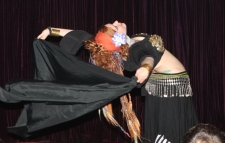on Mon, 19 Jan, 2015

Belly dance is thought to have originated in the Middle East, though contemporary belly dance uses music, costuming and moves from many folkloric traditions. There are several ideas about belly dance’s origins and functions. Whether familiar with belly dance because you saw it at a show in Eugene and are about curious what it is, or you are a seasoned dancer wanting to know more, this post briefly describes the origins of the dance.
There are dances described in texts from Ancient Rome, Greece and Egypt in which women dance to entertain men or a royal court that modern scholars believe to be belly dance. In the biblical story of Salome dancing for King Herod it is thought that was be the equivalent to stripping. Oscar Wilde popularized stripping in contemporary culture in his play “Salome” with the infamous “7 Viels Dance.” Sometimes belly dancers remove viels, sometimes multiple viels. Often they do so without considering the connection between what they are doing to the Salome reference, and do not see what they do as stripping. Permitting body tipping during dancing causes audiene members to draw further parallels. Today’s cabaret style belly dance performed in a nightclub or restaurant carries on in the tradition of entertainment or sex appeal just as it once did in a pharoah or sultain’s court.
Another idea behind the origins and purpose of belly dance is that many moves originated by women for women—and in some Middle Eastern cultures they are still practiced that way. In these tribal dances, belly dance is the equivalent of sex education and tribal Lamaze for birthing. Dancer and belly dance scholar, Morocco, explained in a number of articles in the 1970s her experiences observing belly dance in modern Middle Eastern tribal culture as a way to celebrate, connect and educate a woman as she is birthing. In Grandmother’s Secrets, Rosina-Fawzia Al-Rawi talks about the connection between belly dance moves and birthing practices in modern Arab cultures. These are moves done for women’s eyes only.
One interesting account is an American woman who used belly dance for birthing.Since I have never had a baby, let alone one I belly danced with, I don't know how helpful this actually is, however, I will say Elisa looks really beautiful and calm while she is having her contractions.
https://www.youtube.com/watch?v=U9K4bYlvzv8
Some belly dance philosophers and scholars claim that belly dance is a symbol of the goddess and fertility. Certainly many modern dancers feel a spirituality in performing the dance. In some cultures it is considered good luck to have a belly dancer dance at a wedding and to som symbolizes fertility. Much of the information we have is incomplete, anecdotal or fragmented. Because we didn’t have YouTube a thousand years ago, it is hard to say exactly how old it is and when and how it was used, but the leading theories are that belly dance was used as entertainment, storytelling and it was used as a way to pass on knowledge—whether that was spiritual or practical.
To understand where the term belly dance came from in modern American culture see upcoming posts titled:
What is the Difference Between Middle Eastern Dance, Belly Dance and Folkloric Dance?
What is the Difference Between ATS (American Tribal Style), Cabaret, and Tribal Fusion Belly Dance?
What is the Difference Between Belly Dance, Burlesque, Stripping and Exotic Dance?